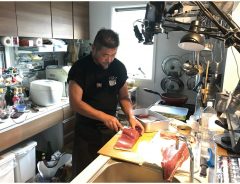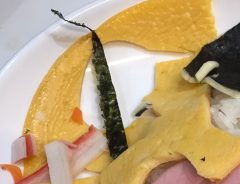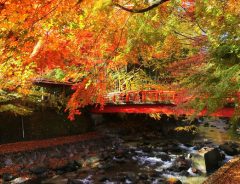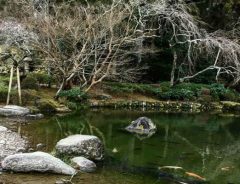
© Grape Japan / © Sanriku Railway Co., Ltd. / © Yomeishu Seizo Co., Ltd.
Stay Warm And Entertained In Winter Aboard The Yomeishu Kotatsu Train
- Tags:
- abalone / ama / Amachan / amber / awabi / bento / Construction / diver / Earthquake / Fishermen / fishing / fishing industry / Folklore / Great East Japan Earthquake / herbal liqueur / hotate / Iwate Prefecture / Knife / Komagane / Kotatsu / Kotatsu Train / Kuji / Kuji amber / Kuji Amber Musuem / mamebu / mibyou / mino / Miyako / namahage / namomi / NHK / ogre / Oomiya / pearl diver / Raiho-shin / reconstruction / recovery / recovery effort / regional revitalization / Rena Nonen / Sanriku / Sanriku Coast / Sanriku Kaigan / Sanriku Railway / scallops / Sea Urchin / straw coat / tidal wave / tonic / Tourism / Tradition / train attendant / train conductor / Tsunami / TV drama / Uni / Yomeishu / Yomeishu Kotatsu Train
Related Article
-

Love to Eat Delicious Tuna? Learn How from Fish Guru Katsuhiko Ueda
-

Awesome Dad Turns His Daughter’s Doodles Into Adorably Accurate Bento
-

Japanese parent warms heart online showing the struggle of making character bento for their kid
-

Japanese Government Releases Stock Free Photographs Of Japan’s Breathtaking Sceneries
-

Japan Travel: What are the Best Temple Recommendations for Setsubun’s Mamemaki?
-

“Uni Bagna Càuda” is an umami-rich sea urchin sauce for veggies, pasta, and more


Updated: Dec. 6, 2018
The Sanriku Kaigan is a beautiful coastline extending along the Pacific Ocean from southern Aomori prefecture, through Iwate prefecture and northern Miyagi prefecture. Popular for scenic spots, seafood, diving and hiking trails, it unfortunately suffered heavily from the Great East Japan Earthquake and tsunami on March 11, 2011, like many other places in the Tohoku Area.
Mamusi Taka [CC BY-SA 3.0], via Wikimedia Commons
The Sanriku Railway, the lifeline of the coast for residents as well as tourists, was badly hit, with over 5.8 kilometers of tracks washed away. However, with the exception of one segment between the towns of Miyako and Kamaishi expected to reopen next spring, service to the railway was restored in 2014, building confidence and instilling hope in local residents as the region continues steadily on the path to recovery. Therefore, taking a ride on the Sanriku Railway, when combined with a travel plan along the Sanriku Kaigan, is a memorable and wonderful way of contributing to the recovery effort while enjoying this beautiful part of Japan.
By Alt_winmaerik (Own work) [CC BY-SA 3.0], via Wikimedia Commons
Although your first instinct may be to avoid this northerly region during the cold winter season, winter offers many charms. In fact, your trip on the Sanriku Railway can turn into a very special experience if you take advantage of the Kotatsu Train which runs regularly from December to March. A common fixture in many Japanese homes during winter, kotatsu are low wooden tables covered by a heavy blanket with a heat source built underneath. On the Kotatsu Train, the carriage is fitted with kotatsu so that you can enjoy the coastal view from the window while feeling warm and snug, feasting on bento lunch boxes featuring fresh local seafood. But everything isn't calm and quiet. Representing local folklore, two namomi, Krampus-like creatures in heavy ogre masks and straw capes wielding wooden knives will also entertain you.
And now that namomi and their like in other parts of the country have been recognized by UNESCO as Intangible Cultural Heritage of Japan, it makes your train ride on the Kotatsu Train even more special.
From December 16, 2017 to January 14, 2018, Sanriku Railway offered a special version of the Kotatsu Train in collaboration with the makers of Yomeishu, a remarkable tonic herbal liqueur enjoyed throughout the country which warms you from the inside and promotes general health and well-being. Curiosity piqued, our Grape Japan staff embarked on a journey to Iwate Prefecture to experience the Yomeishu Kotatsu Train for ourselves and report it to you.
Our journey started at Kuji, a small city in northern Iwate Prefecture and the northern end of the Kita-Rias segment of the Sanriku Railway. Kuji is famous for two things, first, for its amber mining and production, having the world's oldest deposits dating back 85 million years, and second, for being the northernmost location where female divers, known as ama, dive for shellfish, seaweed and pearls. It was also the setting for a very popular Japanese TV drama called "Amachan" about a high-school girl from Tokyo (portrayed by Rena Nonen) who moves to the Sanriku Coast to become an ama, turns into a local idol, goes back to Tokyo to try to become a real idol, and finally returns to Tohoku to help revitalize the area after the Great East Japan earthquake.
Let's head for the station because we have a train to catch!
Sanriku Railway's Kuji Sation is easy to spot in a pinch. The JR station next to it is green, for the JR theme color, while the Sanriku Railway station is orange. The sign may mislead some people into thinking there's an amber mine inside, since it says: "Amber Kingdom: Kuji Station," but this is just simply some very exuberant advertising. The Kuji Amber Museum is located a bus-ride away.
Source: © grape Japan
Once inside, you'll see attractive tour advertisements along with Amachan signs and posters, and a big banner advertising "uni bento" (sea urchin bento) which you can partake of during your train ride. If you're wondering about the Taiwanese flag, charter flights between Taipei and Hanamaki have been bringing Taiwanese tourists to the region in the last few years.
Source: © grape Japan
The waiting area has a few traditional costumes where you can take commemorative pictures, including a namomi costume. Unless you take the trip from Miyako Station to Kuji Station, going south to north, you may want to take advantage of it before you board the train because you won't find this at Miyako Station when you end your journey.
Source: © grape Japan
Here is the ticket counter where you purchase your special ticket on the Yomeishu Kotatsu Train. Tickets cost 2,160 JPY for a reserved seat.
Source: © grape Japan
While you wait, a cute assistant robot will provide information in English (and a few other languages) upon request.
Source: © grape Japan
This proof of boarding is a collector's item, as you can see:
Source: © grape Japan
After crossing an overpass, we saw our train waiting at the platform:
Source: © grape Japan
Painted chocolate and dark russet with a white stripe, and the kanji 三陸鉄道 Sanriku Railway in gold calligraphic lettering along the side, it has an elegant, vintage feel to it. A round name plate at the back of the train says Yomeishu Kotatsu Train.
Source: © grape Japan
Source: © grape Japan
Three years after the Great East Japan Earthquake, the government of Kuwait funded the construction of three new diesel railcars to replace three which were damaged. The Yomeishu Kotatsu Train we boarded used one of these new cars, introduced by Sanriku Railway in January 2014.
Source: © grape Japan
Stepping inside the train, we were startled at the interior. Even though we knew it was going to be different than a conventional train, nothing could have prepared us for the sight of comfortable-looking kotatsu tables, iconic fixtures of the traditional Japanese living room, arranged neatly throughout the carriage. To our grape Japan staff, who enjoys a daily cup of Yomeishu in winter and swears by its warming and invigorating effects, before even noticing the logo printed in the center of each table, their color instantly evoked the familiar crimson of the Yomeishu box, enhancing the welcoming atmosphere and creating an almost Pavlovian warming effect.
Source: © grape Japan
Humorous advertisements featuring an anthropomorphic Yomeishu bottle were affixed to the panels between windows, further enlivening the mood.
Source: © grape Japan
Adding to the authenticity of the experience, the seats were tiled with genuine tatami mats. The thick padded blankets which seal in the warmth of the kotatsu were printed in a pattern of miniature Yomeishu bottles.
Source: © grape Japan
After we had stored all of our belongings at our table, we exited for a few more exterior shots. Our beautiful train attendant, Ms. Kitamura, agreed to interrupt her duties for a moment as she posed for our camera.
Source: © grape Japan
We had a few minutes before the train departed Kuji Station, so we took the liberty walking through the carriage. There's the Yomeishu bottle mascot, but he looks different. Now, where have we seen that straw coat and knife before?
Source: © grape Japan
Yomeishu added a special flourish to their collaboration on the Kotatsu Train with this colorfully decorated tairyo-bata, a Japanese fishermen's flag. When Japanese fishermen have a great catch of fish, they hoist a flag like this on their boat to announce the good news to family members or colleagues waiting for their return on the beach. In addition to fish and other auspicious symbols, the flag has the kanji for Yomeishu written on it, as well as the kanji 祝 meaning congratulations.
Source: © grape Japan
As the train pulled out of Kuji Station, we settled into our cozy kotatsu and enjoyed our lunch. We ordered the top-tier lunch, poetically entitled "Fisherman's Boat Song of the Great Catch," courtesy of locally famous Kuji seafood restaurant Oomiya.
The menu included: mekabu seaweed, bakurai a local delicacy of salted and fermented sea-squirt and sea-snail, sea urchin baked in its shell, grilled abalone, greenling with Dengaku sauce, grilled scallop skewers, mussels, marinated mackerel with wasabi, sliced and seasoned kombu, fried squid legs, and as a unique twist, a tempura of one of the local Kuji specialties, mamebu, dumplings filled with walnuts and brown sugar, all of them artfully placed on a boat-shaped lacquer tray.
Source: © grape Japan
Finally, a plate of grilled rice balls generously filled with flavorful sea urchin, and a side of soy-boiled wakame and shiso leaf completed the meal. For such a feast, we felt it more than deserved its price of 3,000 JPY.
You can also order a sea urchin rice bowl for 1,700 JPY, an abalone bento lunch for 1,600 JPY or a scallops bento lunch for 1,200 JPY. A seasonal desert is also available for 500 JPY. The train attendant will also sell beverages and snacks during the trip. For more details, please see Sanriku Railway's Kotatsu Train website here.
Source: © grape Japan
As we feasted on these local delights, we pulled into the newest station on the Sanriku Railroad's North Riasu line, Tofugaura Kaigan, opened on March 25th, 2017. The rest area on the platform is decorated with artwork provided by local children.
Source: © grape Japan
At several occasions during the trip, our train stopped to give us a good view of the beautiful Sanriku Coast and an opportunity to observe signs of the recovery in progress. Here, we can see fishing boats.
Source: © grape Japan
At Horinai station, which served as one of the locations for the Amachan TV drama, we had a chance to observe the scenery. The Fudai Fishing Union Horinai Seafood Cargo Sorting Facility pictured here was spared the wrath of the tsunami in 2011 but sadly, some houses were washed away.
Source: © grape Japan
The natural beauty of the coastline, with pines growing on jagged rhyolite rock
Source: © grape Japan
And at several stops along the way, we saw constructions sites testifying to the ongoing recovery effort.
Source: © grape Japan
Finally, the entertainment we were all waiting for: As the train ducked into a tunnel, the lights suddenly went out and our attendant announced that the namomi would now enter the train carriage to look for crying children, make sure they were all well behaved and bring about good fortune to all, according to tradition. Impressive in their red ogre masks and shaking their wooden knives, they didn't fail to find crying children as well as happy onlookers. They were even kind enough to entertain requests for pictures:
Source: © grape Japan
Source: © grape Japan
Afterwards, the men removed their masks and treated the passengers to a brief talk on the significance of the namomi, and allowed those who requested it to try on the mask for themselves.
Source: © grape Japan
Before we knew it, we were pulling into Miyako Station, the final stop in our Yomeishu Kotatsu Train adventure. Feeling decidedly in good spirits after a journey in our warm and inviting Yomeishu themed surroundings, our Yomeishu kotatsu seats, entertained by the natural beauty of the Sanriku Coast and the powerful yet friendly namomi, and feeling inspired by the courage and determination of the local people on their path to recovery, we exited the station and ended our journey.
If you would like to take your own Kotatsu Train journey, the train will run on weekends and national holidays until the end of March. Please see more details (in Japanese) here. The fastest way to get to Kuji Station from Tokyo is to take a Shinkansen train to Ninohe, then a highway bus from Ninohe to Kuji Station. If you're able to sleep in a bus and have a limited budget, you can also take an overnight highway bus that will take you there directly.
Source: © grape Japan
A photo panel right outside the station featuring the members of idol group AKB48, along with their signatures, might be the icing on the cake if you happen to be a fan.
Source: © grape Japan
Also, please see our report as we continued our journey in Iwate Prefecture with a visit to the breathtaking rocky vistas of Jodogahama in Miyako Bay.